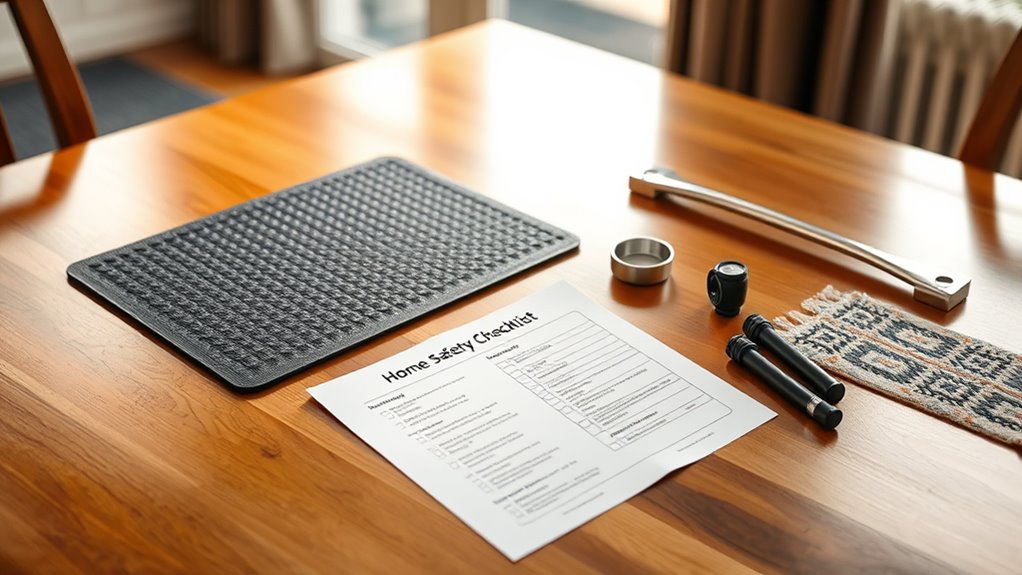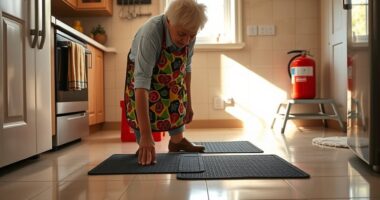To prevent falls throughout your home, start by improving lighting in all rooms, especially hallways and staircases, using bright, energy-efficient bulbs and motion sensors. Install grab bars in bathrooms, secure rugs, and make certain clear pathways free of clutter or uneven flooring. Add non-slip mats and adequate lighting in wet areas, and consider safety technology like smart lighting systems and motion sensors. Staying proactive with these safety measures can make your home much safer—discover more tips below.
Key Takeaways
- Install adequate, energy-efficient lighting throughout all rooms, especially in hallways, stairways, and entry points.
- Add grab bars and non-slip mats in bathrooms and wet areas to prevent slips and falls.
- Remove clutter, secure loose rugs, and repair uneven flooring to eliminate tripping hazards.
- Use safety technology like motion-activated lights and smart sensors to enhance visibility and awareness.
- Ensure pathways are clear, furniture is arranged for easy navigation, and safety features are regularly maintained.

Falls are a leading cause of injury at home, but many of these accidents can be prevented with a proactive approach. One of the most effective steps you can take involves improving your home’s lighting. Poor lighting makes it difficult to see hazards like uneven flooring, loose rugs, or clutter, increasing your risk of tripping or slipping. To enhance safety, install bright, energy-efficient bulbs in all your rooms, especially hallways, staircases, and entryways. Consider adding motion-activated lights in areas you frequently use at night, such as the bathroom or kitchen. Keep light switches easily accessible, and ensure that all areas are well-lit to provide clear visibility. Proper lighting not only helps you see potential hazards but also boosts your confidence as you move around your home, reducing the chance of falls. AI discoveries have also contributed to innovative safety solutions, such as smart lighting systems that adapt to your movement and needs.
Bathroom safety is another vital aspect of fall prevention. Bathrooms are often the most dangerous areas because of wet surfaces and tight spaces. To make your bathroom safer, start by installing grab bars near the toilet and inside the shower or bathtub. These provide stability when sitting or standing and help prevent slips. Use non-slip mats or adhesive strips inside the tub and on the bathroom floor to reduce the risk of slipping on wet surfaces. Ensure that the bathroom is well-lit, especially at night, by adding nightlights or brighter bulbs, so you can see clearly without turning on harsh overhead lights. Keep frequently used items within easy reach to avoid unnecessary stretching or bending, which could cause a loss of balance. Consider upgrading your bathroom fixtures with lever handles instead of knobs, making them easier to operate, especially if you have limited hand strength. Regularly check for leaks or mold, as dampness can make surfaces slick and hazardous. These bathroom safety improvements create a safer environment where you’re less likely to slip, trip, or fall.
Frequently Asked Questions
How Often Should I Review My Fall Prevention Checklist?
You should review your home safety and fall prevention checklist at least every six months. Regular risk assessments help identify new hazards or changes in your environment that could cause falls. By staying vigilant and updating your checklist, you guarantee your home remains safe. Consistent reviews help you catch potential risks early, giving you peace of mind and reducing fall hazards effectively.
Are There Specific Fall Prevention Products Recommended?
Think of fall prevention products as your home’s safety anchors. You’ll want sturdy grab bars, non-slip mats, and well-placed assistive devices that act like guiding stars through your space. Home modifications, like improved lighting and removing tripping hazards, are your foundation. These recommended products and tweaks work together, creating a fortress where stability reigns, and your confidence to move safely within your home shines brighter every day.
Can Fall Prevention Measures Be Customized for Mobility Issues?
Yes, fall prevention measures can be customized for mobility issues. You should focus on personalized adaptations, such as installing grab bars or ramps tailored to your needs. Incorporate mobility-specific strategies like using walkers or non-slip mats in key areas. These adjustments help create a safer environment, reducing fall risks and enhancing your confidence at home. Consulting a professional can also guarantee the solutions fit your mobility level perfectly.
How Do I Involve Family Members in Fall Prevention?
You involve family members in fall prevention by encouraging open family communication and sharing safety concerns. Educate them through caregiver training so they comprehend how to spot hazards and assist effectively. Invite them to participate in home safety assessments and fall prevention planning. By actively engaging your family, you create a supportive environment where everyone works together to reduce fall risks and ensure safety for your loved one.
What Are the Costs Associated With Implementing These Measures?
Did you know falls cost Americans over $50 billion annually? The costs for fall prevention measures vary; a thorough cost analysis helps you identify affordable options. Budget planning ensures you allocate funds wisely, covering simple fixes like grab bars or more extensive modifications. While initial investments may seem high, they can considerably reduce injury-related expenses over time, making fall prevention both a smart financial and health decision for your home.
Conclusion
By following this whole-home fall prevention checklist, you protect yourself, create safety, and promote confidence. You identify hazards, eliminate risks, and guarantee ease of movement throughout your home. You stay vigilant, stay prepared, and stay safe. Because prevention is proactive, awareness is essential, and safety is a priority. Take these steps today to prevent falls tomorrow, to foster independence today, and to enjoy peace of mind always. Your safety begins with you—start now, stay consistent, and stay safe.









